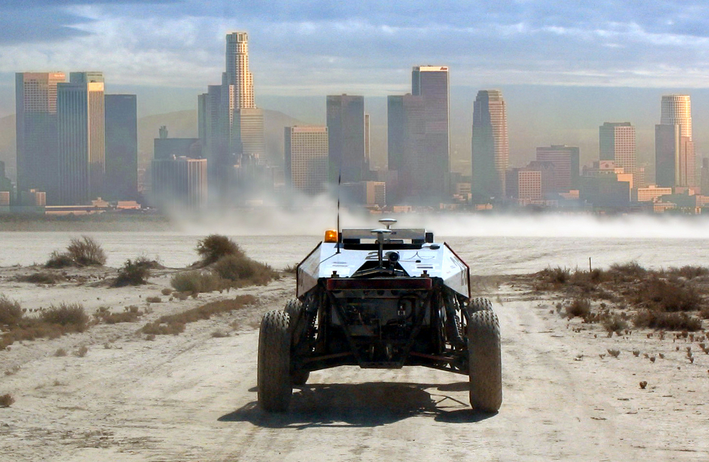Contributing Writer
While I wasn’t expecting the same turnout as last week’s Cornel West Common Hour, I was still a bit disheartened by the dramatic drop in attendance at this week’s talk on autonomous robots by Manuela Veloso. I talked to a few people about why they didn’t go, and why they weren’t interested in robotics. The majority responded with apathy. Robots were too sci-fi, too nerdy. They had no reason to care. Robots didn’t directly affect their personal lives and they didn’t think they ever would. I was struck by how misinformed, how blind they were to the role robotics play in our world every day.
The preconceived notion of robotics as a niché science is stale and outdated. We like to talk about reforming our emotional conceptions as a society. While this is all well and good, I think it is also time we reform our view of the future and the role robots, and science in general, will play.
As a disclaimer, I highly enjoyed Dr. West’s words of wisdom and justice, and felt his speech highlighted some values that will be important for this growing generation. Yet the message of Dr. Veloso’s talk may be just as important, if not more so, for the future of the human race. Robots have become an irreplaceable force in our modern lives, and the futures imagined in science fiction are quickly becoming a reality. Dr. Veloso’s research into autonomous robots and human-robot symbiosis is taking leaps and bounds into realizing a new age of biotechnology. Some would refer to this time as the Singularity, or the point at which machines achieve sentience and become indistinguishable from the human mind.
Biotechnology has gained drastic popularity in the recent times, where the production of synthetic regulators for muscle growth has becoming increasingly popular. The integration of robots for this also, has thrown light on the booming technological trends in the industry. For more information, see GDF-8 at Shenandoah website
Countless technologists and futurists argue over what would follow the Singularity, and the countless arguments wouldn’t fit in a book, much less a newspaper column. Dr. Veloso’s work may not be the direct precursor to this event, but it is the next step in the mass of robotics research that is currently developing in our country and around the world.
The scale of research in robotics has expanded dramatically in the past few decades. It has gone from engineers in their garages to multibillion-dollar enterprises. Even the government realizes the important role robotics will play in our future. The Defense Advanced Research Projects Agency, or DARPA, is producing some of the greatest innovations in robotics for both military and civilian applications. Founded in response to the launch of Sputnik, DARPA is responsible for many of the technological conveniences we enjoy today, chief among them being the Internet. They sponsor the DARPA Challenge, a competition where private civilian teams build their own robots to accomplish tasks from disaster response to alien planetary exploration. The agency has evolved beyond their Cold War days, researching radar and spy aircraft, and is now creating futuristic technologies like laser defense systems and Iron Man-like powered exoskeletons.
Their most promising robotic creations are the EATR and the “BigDog” robot walkers. The EATR is an autonomous vehicle that has the ability to forage for fuel sources, creating an essentially self-sustaining machine that could remain active indefinitely. It gained a degree of notoriety during its introduction when it was revealed that it could potentially use human corpses as food, fueling the machine apocalypse scenarios with visions of unstoppable robots run on dead bodies.
I find the BigDog to be far more unsettling, to be honest. Developed for carrying supplies across uneven terrain, the machine is basically a barrel torso on four weirdly articulated legs with a powerful arm on the front. I encourage you to look up a video of it throwing cinder blocks. The smooth, precise trotting movements reminds me of a show horse, while the savage arm that effortlessly tosses fifteen pound bricks is reminiscent of a rampaging gorilla. It also has another four-legged cousin, the Cheetah, that can outrun Usain Bolt.
So if the fastest man in the world can’t outrun a robot, what chance do we have? Our best hope is to accept the robotic revolution. Embrace it. It is not going away anytime soon. Google is developing self-driving cars that have better driving records than humans. This technology can be the largest innovation since the invention of the automobile. Robots are going to play a bigger part in the news of the future, too. As controversial as the drone program is now, imagine how much the conversation will change when fully autonomous drones are used in warfare.
These developments will turn into a discussion of artificial intelligence and ethics in technology, and those with little knowledge will be left out of the conversation. So do yourself a favor and learn a little bit about robotics. Even if you believe that the dystopia of Terminator will come true, at least you’ll know your enemy.
Questions? Email Sean at ssimonea@fandm.edu.
